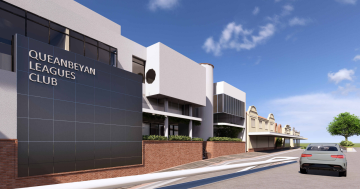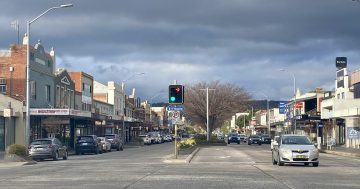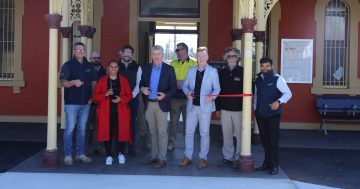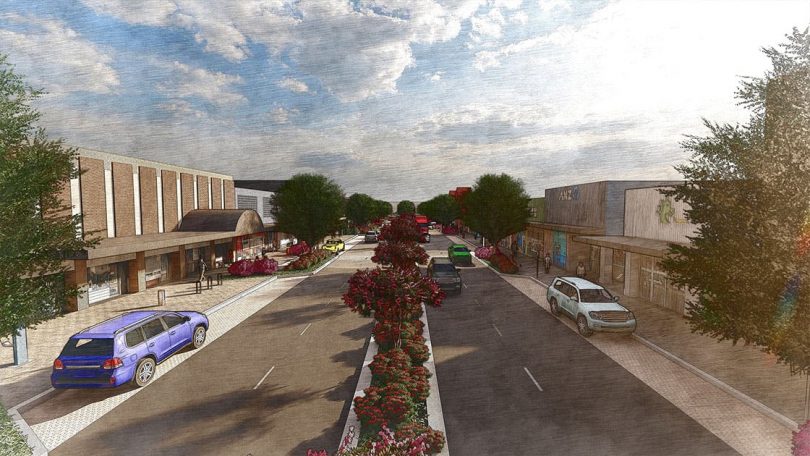
An artist’s impression of the new-look Monaro Street in Queanbeyan. Photo: Queanbeyan-Palerang Regional Council.
Monaro Street runs through the heart of Queanbeyan, and it’s a busy thoroughfare for not only local traffic and businesses but hundreds of Canberrans on their summer pilgrimage to the NSW South Coast.
It’s a constant battering has left it looking rather drab, but help is finally at hand.
The redevelopment of Monaro Street forms the third stage of a masterplan to improve the amenity of Queanbeyan’s CBD.
The ‘Queanbeyan CBD Spatial Master Plan’ was developed in 2019 and sets out a vision for a ‘contemporary city with a country heart’. It also includes a tidy up of the pedestrian laneways branching off Monaro Street, and the redevelopment of 257 Crawford Street, Queanbeyan-Palerang Regional Council’s old administration building.
The proposed designs include the area of Monaro Street between Lowe Street and Collett Street, however construction will only take place on the section of Monaro Street between Lowe Street and Crawford Street.
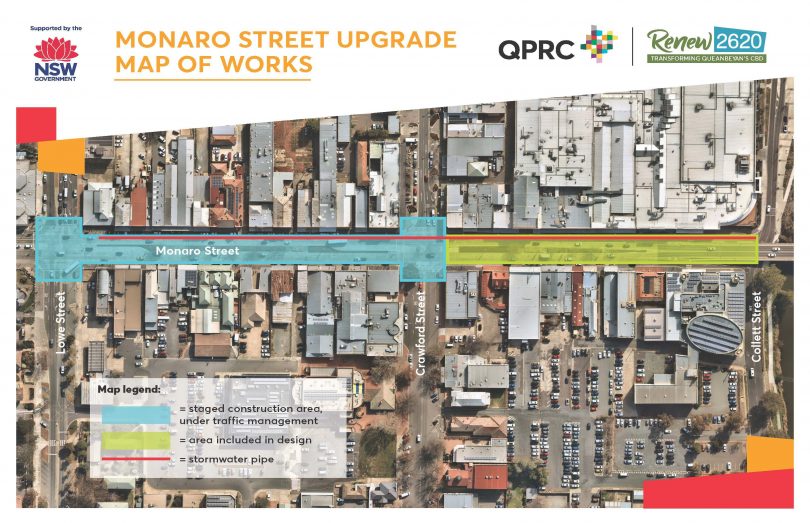
Overlay map of proposed work zones for Monaro Street upgrade in Queanbeyan. Photo: Queanbeyan-Palerang Regional Council.
Footpaths will be refurbished with new paving, lighting, greenery and seating. Where possible, they will also be widened to provide additional space and accessibility for pedestrians.
The height of the kerbs will drop, along with the speed limit – down from 50km/h to 40km/h. A new road surface will be installed to reduce traffic noise along the street.
Parallel parking will remain, but hopefully all of these changes make it less perilous.
Currently, 11 Japanese elm trees line the centre island. The number of large street trees is set to rise to 36.
The project will also include vital work below ground, such as improving drainage and realigning utilities.
All up, the project has been funded by a $10 million grant from the NSW Government, with Queanbeyan-Palerang Regional Council (QPRC) contributing an additional $5.5 million.
Construction will start in 2022 and be completed within 12 months.
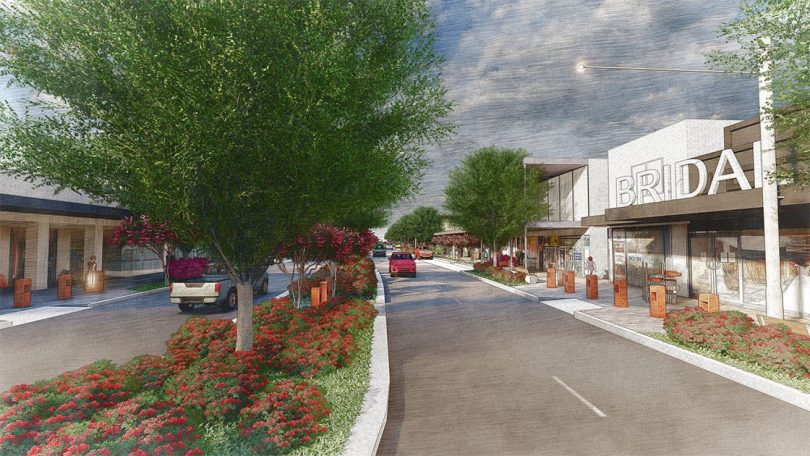
A total of 36 trees will decorate the centre and sides of the upgraded Monaro Street in Queanbeyan. Photo: Queanbeyan-Palerang Regional Council.
In the first surveys of the area, conducted in April 1838, the street was dubbed ‘Moneroo’ and adjacent streets were sprawled around it in a grid pattern. This was a few months before Queanbeyan was officially proclaimed a township with a population of 50.
Since then, many businesses have come and gone except for – most notably – Walsh’s Hotel and the Royal Hotel Queanbeyan. Many of these older-style buildings remain, their two-story design testament to a time when owners lived above their shops.
The bustling border town is now home to more than 61,000 people.
Throttle Media is a web-design company based on Monaro Street, and owner Charlie Tizzard says the beautification of the main street will be a massive plus for his and the many other business positioned on both sides of it.
“There was plenty of community consultation and council has actively listened,” he says. “It all just hangs on the execution.”
Charlie can see the rejuvenation of the buildings being the next step.

Charlie Tizzard, who owns Throttle Media, is a sixth-generation Queanbeyaner who is looking forward to the Monaro Street upgrade. Photo: Thomas Lucraft.
Queanbeyan City Travel moved from inside Riverside Plaza to directly opposite the plaza’s entrance on Monaro Street several years ago. Jenny Cooper has run the travel agency for years and is also excited about the upgrades taking place on her doorstep.
“It will be nice to finally swap the messy and lumpy patchwork of concrete for quiet and smooth tarmac,” she says.
At Jenny’s end of the street, near the Queanbeyan River bridge, parking has never been an issue. Most people opt for either the undercover plaza car park or the Queanbeyan Leagues Club car park. Those who park on the street are usually only ever ducking in and out.
Jenny describes local reaction to the proposed upgrade as mixed, but she says council is “damned if they do and damned if they don’t” proceed with it.
“Council doesn’t own the main road – the NSW Government does, and it decides what should be done to it,” she says. “If people have an issue with it, take it up with NSW Deputy Premier John Barilaro.”
Council says its liaison team will continue to engage with landlords and businesses along Monaro Street to mitigate the impact of construction.
It is now seeking comments on designs for the upgrade. Artist impressions and design documents are available on the QPRC website, and residents are encouraged to have their say before Sunday, 15 August.
Original Article published by James Coleman on The RiotACT.







